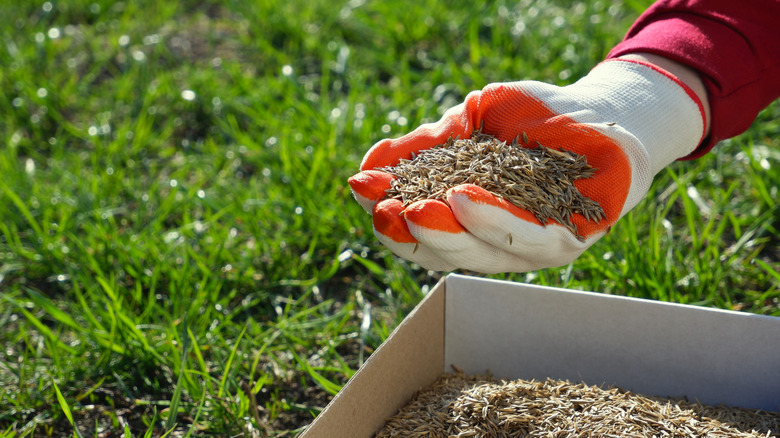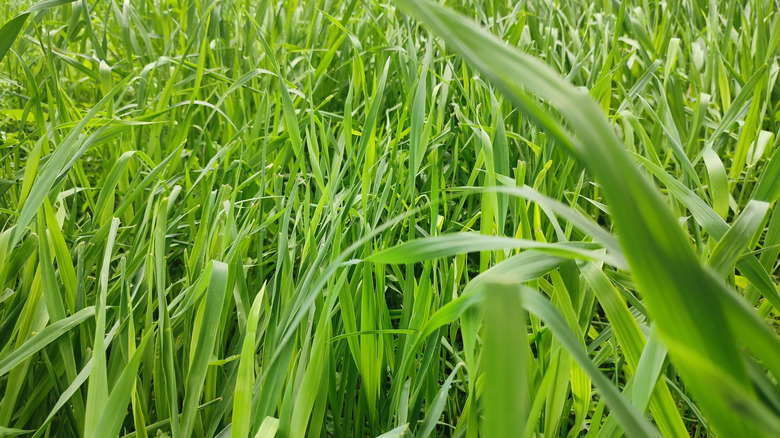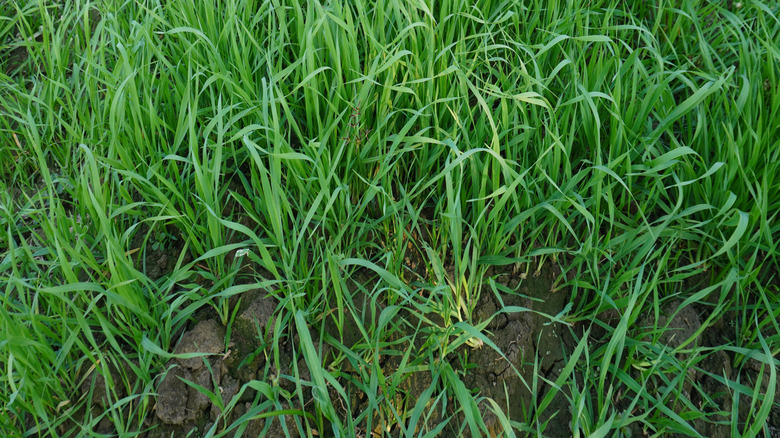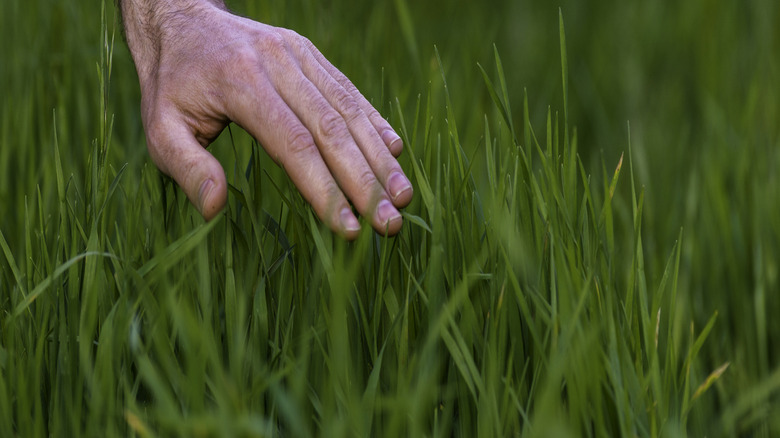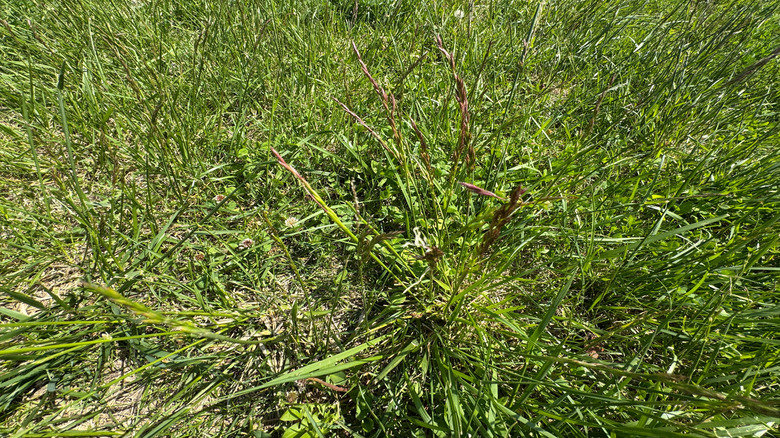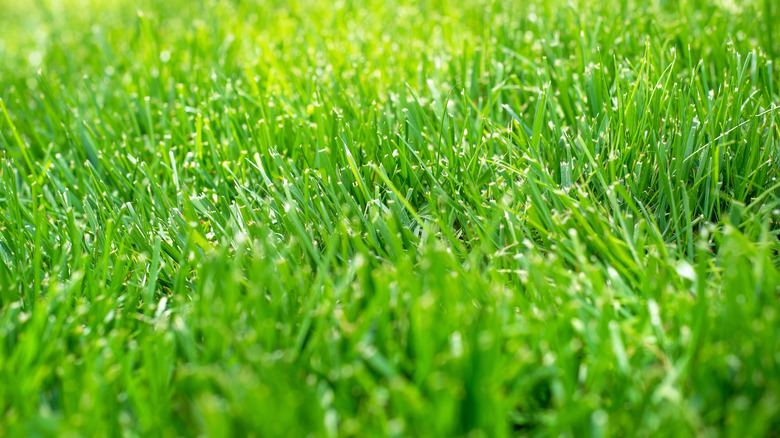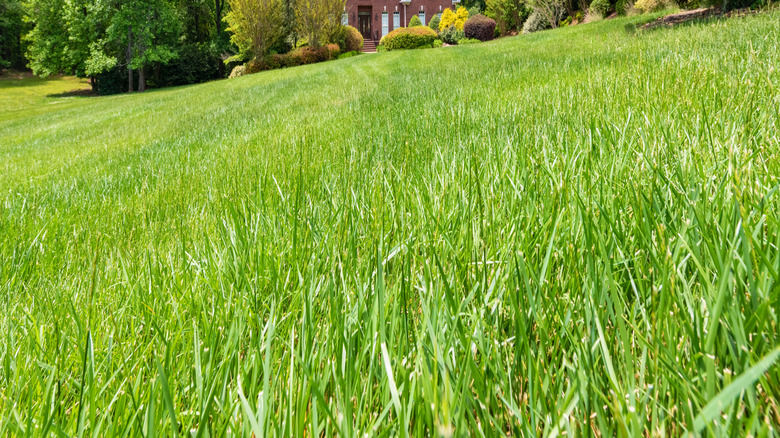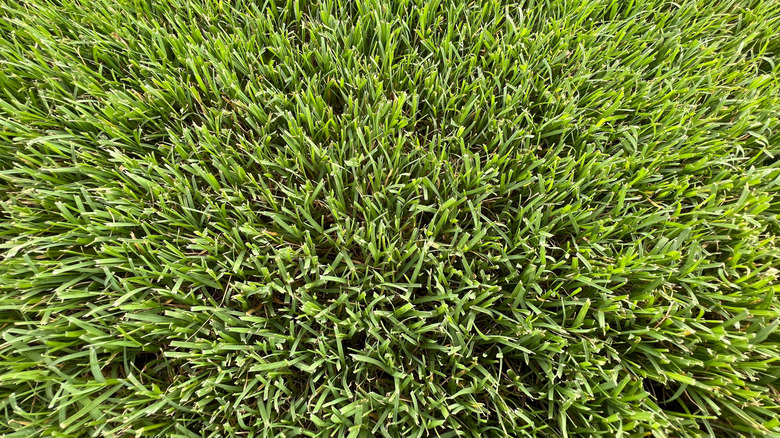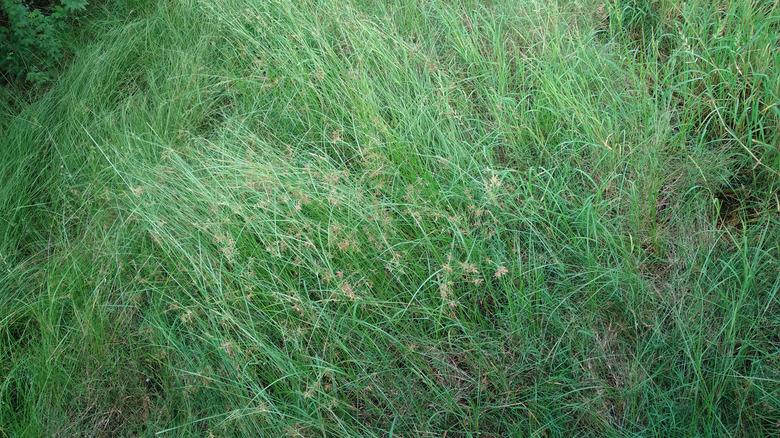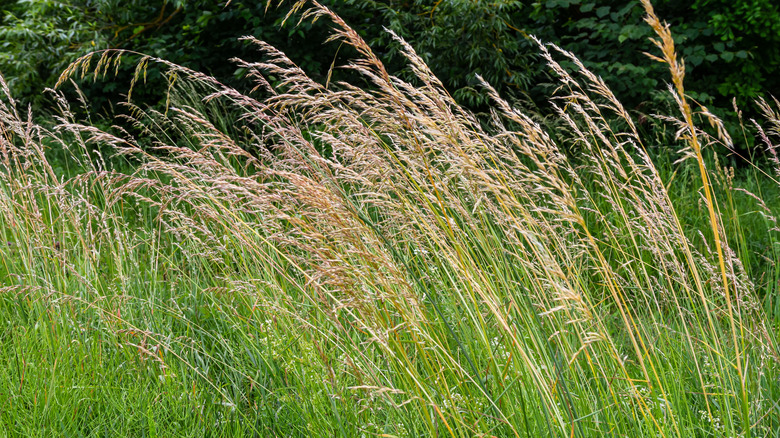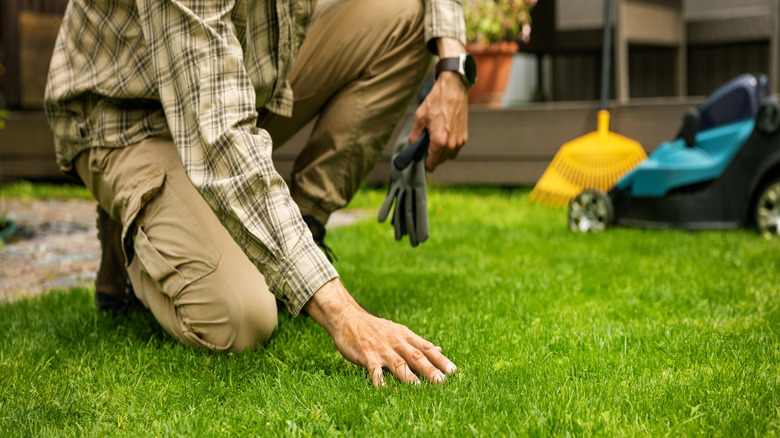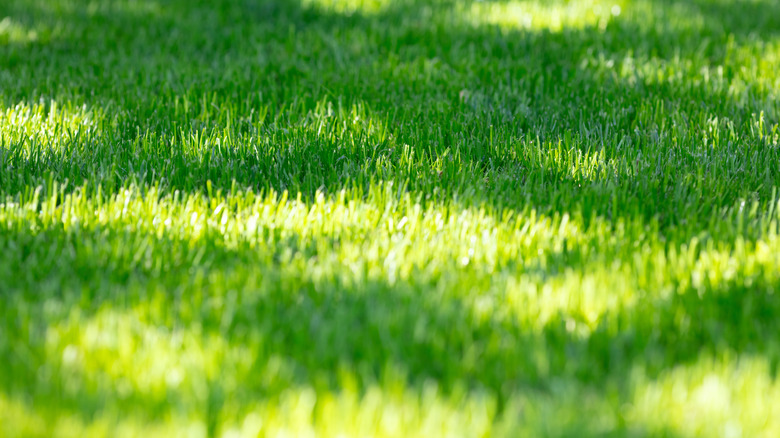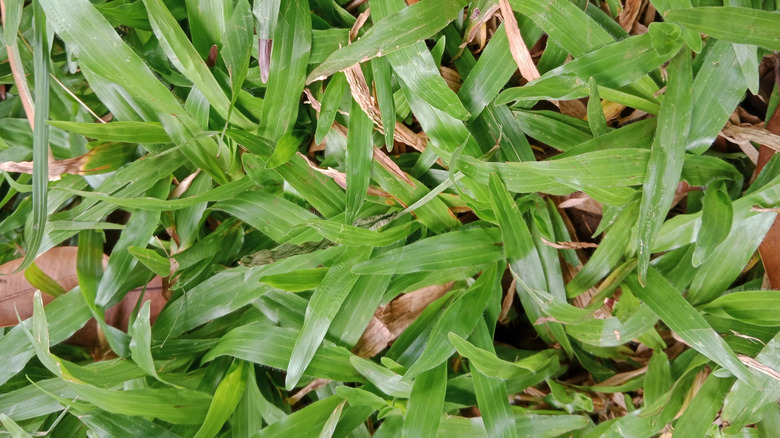12 Of The Fastest Growing Grass Seeds For A Luscious Lawn In No Time
Whether you're revamping your lawn due to spotty patches or planting a new lawn, you're probably looking for a fast-growing grass seed that'll have your yard lush and covered in no time. Luckily, there are a variety of both cool and warm-season grasses that will sprout up quickly. Some popular grass seeds, such as Kentucky bluegrass, may take up to 30 days to start sprouting, but other options can germinate in as little as 10 days or less. For those that don't want to wait a whole month for their lawn to start growing, seeds from many ryegrasses and fescues are fantastic choices. Several varieties of both of these turf types will germinate in about a week, allowing you to plant a gorgeous, green lawn for your home that won't require tons of patience.
When choosing a grass seed for your lawn, it's important to consider your local climate, as well as the conditions of your yard. You'll need to ensure that the soil and sunlight requirements of the grass are compatible with your outdoor space. Additionally, check that the grass you want will be capable of weathering harsh winters or thriving through hot summers, depending on your location. With these factors in mind, you can pick the best grass for your yard specifically, and create a lush lawn from seed in no time.
Perennial ryegrass can sprout in less than a week but is vulnerable to disease
For those who live in colder climates or transition zones and are looking to plant and grow cool-season grass seed, perennial ryegrass (Lolium perenne) will bring your lawn to life rapidly. These seeds can start to sprout in as little as five days, making them a great choice to get quick coverage. In some cases, perennial ryegrass seeds could take a little over a week to germinate. Perennial ryegrass is often found in seed mixes due to its fast germination period and looks great as a manicured lawn because of its thickness and dark green color.
While perennial ryegrass grows quickly, it often suffers from disease when it's not mixed with other grasses. You might consider combining your perennial ryegrass with Kentucky bluegrass or another variety to allow a quick start with less susceptibility for disease. Additionally, this grass doesn't fare well in excessive hot or cold temperatures, though it can thrive in areas with cool, moderate weather. While perennial ryegrass can tolerate some shade for a period of time, lots of direct sunlight allows your lawn to thrive. Perennial ryegrass also performs well in soils that are just a little bit acidic and damp. For those who need coverage as soon as possible, perennial ryegrass is a great way to get your lawn started.
Annual ryegrass germinates quickly but is only a temporary solution
Another type of ryegrass that germinates particularly fast is annual ryegrass (Lolium multiflorum), also known as Italian ryegrass. These seeds are able to sprout in a span of five to 10 days, similar to perennial ryegrass, and it's also a bunching variety of turf. This ryegrass has a lighter green color that will make a lush, established lawn in hardly any time at all. Unfortunately, there are some serious drawbacks to planting fast-growing annual ryegrass seed.
Annual ryegrass has a shorter lifespan than many other types of grass and will die out when temperatures rise. Because this grass is so impermanent, seeding with it is best as a temporary solution. When planted for very quick coverage to protect the soil or to overseed in warmer climates during winter, annual ryegrass is a wonderful option. If you need to overseed bermudagrass, this grass seed works rather well, though it does not combine with some tall fescues, Kentucky bluegrass, or perennial ryegrass. Annual ryegrass loves lots of sun, but can handle partial shade. Additionally, well-draining but moist soil is ideal for this grass, but it's capable of growing in both clay and sandy soils. Because it's a cool-season grass, annual ryegrass struggles in warmer temperatures, but it's also not suitable for bitter winters.
Turf type tall fescue sprouts in a week or two and resists many issues
If you're looking for a grass that's easier to grow and keep up with, turf type tall fescue (Festuca arundinacea) may be perfect for your lawn. This cool-season grass typically germinates in just one to two weeks, and is relatively hardy against disease and insect issues. Additionally, tall fescue is resistant to drought due to its deep roots, as well as foot traffic, making it a relatively easy lawn to maintain. Many turf type tall fescues look like Kentucky bluegrass with thin blades and vibrant color. This grass is a gorgeous pick for your outdoor space that will get your lawn growth started on the double.
While some grasses are particular about soil, tall fescue can grow in a variety of conditions. Even when your soil doesn't have an abundance of nutrients, this grass can still thrive. Turf type tall fescue also has some resistance to a bit of shade, though it prefers to have a minimum of four hours of direct sunlight each day. While this grass seed is generally simple to plant and care for, it will need to be mowed more often than some other grasses because it grows and establishes so quickly. These seeds don't mix well with perennial ryegrass, the fine fescue grasses, or Kentucky bluegrass.
Creeping red fescue sprouts up fast and spreads through your yard
If you're seeking a seed alternative to perennial ryegrass that still germinates quickly, look no further than creeping red fescue (Festuca rubra). With its vibrant green color and thin, delicate-looking leaves, creeping red fescue is a stunning addition to any yard that will sprout in approximately five to 12 days. This variety of fine fescue is a North Hemisphere native and known to establish a bit faster than some others, such as sheep fescue and hard fescue. Though it is a bunching type of grass, creeping red fescue spreads itself through rhizomes, allowing it to speedily fill out your lawn. Creeping red fescue thrives in cooler climates and goes dormant during hotter summer months.
For those who have had trouble keeping their grass green in shady yards, creeping red fescue seeds will come to the rescue. Due to its ability to handle sunny and shady conditions as well as several different soil types, it's easy for this grass to thrive in a variety of outdoor spaces. This seed's resilience, habit of spreading, and quick germination time make creeping red fescue a great choice for a traditional home lawn, especially if you want a fine fescue.
Chewings fescue can tolerate infertile soil and germinates in about a week
Another variety of fine fescue grass, Chewings fescue (Festuca rubra commutata) has a similar germination period to creeping red fescue (five to 12 days); however, it is often a thicker grass with roots that stretch deeper into the soil. Most of the fine fescues are very similar in appearance, and Chewings fescue is no exception. The leaves of this grass are also fine and bright green, though they may not be as dark of a color as hard fescue. Unlike the creeping red variety, Chewings fescue doesn't typically produce rhizomes or stolons that let it spread through your yard.
Because they're resistant to colder temperatures, these grass seeds will thrive in cooler locations, but may suffer disease in areas with rainy, hot summers. Chewings fescue flourishes in soil that's well-drained and a bit acidic. While some other grasses require very fertile ground, this fine fescue can thrive without as many nutrients. Additionally, Chewings fescue may have a slightly better tolerance to shade and lower mowing heights than some other types of fine fescues.
Hard fescue is easy to care for and quick to sprout
Similar to the fine fescues mentioned previously, hard fescue (Festuca brevipila or Festuca longifolia) is a cool-season grass that makes growing a lush lawn in the shade a breeze due to its tolerance. Hard fescues tend to have a deep green color and leaves that are slightly wider. This grass is also exceptionally tolerant of drought and soil infertility. Unfortunately, hard fescues don't always germinate and establish as quickly as Chewings or creeping red fescue. While the seeds may begin to sprout in as soon as five days, it can sometimes take up to two weeks.
Despite the slightly longer germination time, hard fescues can still be a wonderful way to grow your lawn from seed without too much waiting. Additionally, hard fescue turfs tend to fare better against hot weather and can also be used in mixes with other grasses. Kentucky bluegrass, various fine fescues, and perennial ryegrass are all great combinations for hard fescues. For those looking for a pretty, easy to maintain grass for a shady yard with hotter summers, try sowing some hard fescue seeds in your lawn.
Bermudagrass may take longer to germinate but establishes quickly
If you live in a place with hotter weather, bermudagrass (Cynodon dactylon) is a warm-season species that can help grow your lawn from seed quickly. Because of its creeping nature due to producing rhizomes and stolons, bermudagrass can become completely established within six weeks. While there are many varieties of this grass, Cheyenne seeds establish particularly fast. Bermudagrass seeds will sometimes germinate in 10 days, but it may take up to a month for them to sprout. The leaves of bermudagrass have the slightest gray hue to their green color, but will still look luxuriously lush in your yard.
To ensure your bermudagrass lawn thrives, you'll want warm weather and lots of sun shining on your lawn. Because it's not resistant to shade or cooler temperatures, bermudagrass may begin to die in these conditions; however, it's very accepting of many different soil types as long as they drain well. Bermudagrass tends to grow beautifully in soils with an acidic pH above 5.5. With these seeds, a warm, sunny yard will have fresh, established grass in just weeks.
Buffalograss can germinate particularly fast at the beginning of summer
Though it may not move quite as fast as bermudagrass, buffalograss (Buchloë dactyloides) also uses stolons to spread throughout your lawn quickly and thrives in warmer climates. Depending on when you sow the seeds of this plant, it could take more or less time to grow. Though it will sometimes take about a month for buffalograss seeds to germinate, they may sprout up within a week if you plant them at the start of summer. Summertime planting will also allow the turf to establish faster, which pushes out weeds. Because of their intolerance to cold, these grasses go dormant for a period of time once fall weather rolls in. The leaves turn brown during this time, but will green up again once spring arrives.
To grow buffalograss in your lawn, you'll want to have full sunlight for it to thrive, though several hours of direct sun will be alright. Even though this grass is very tolerant of heat and drought, providing it with extra water can help it to establish better. Luckily, you also won't need to mow too much after planting these seeds, as buffalograss is generally a low-maintenance turf, and it'll only require fertilizer a couple times per year.
Rough bluegrass thrives in yards with wetter soil and sprouts in just over a week
If you're having trouble growing lush green grass in shady spots in your lawn, rough bluegrass (Poa trivialis) can prove exceedingly helpful. This cool-season grass seed thrives in areas with an abundance of water and shade, making it ideal for yards that often become very moist or don't receive too much sun. In a span of seven to 10 days, rough bluegrass seeds will germinate, and after that, quickly spread through your lawn. While it appears almost the same as Kentucky bluegrass, it sprouts in much less time. Rough bluegrass has a lighter green color and a glossy sheen to its leaves that'll make for a dazzlingly luscious outdoor space.
Unfortunately, in certain areas, rough bluegrass is considered a weed when it pops up, particularly in lawns with turf type tall fescue or Kentucky bluegrass. Despite this, it can still be a great choice for your yard depending on your needs and where you live. For those in warmer areas, rough bluegrass is a great choice for overseeding yards with bermudagrass in the winter; however, it won't do well once summer temperatures arrive. Generally, this type of bluegrass thrives in moist soil and will help your damp, shady yard to look green and lush.
Creeping bentgrass can transform your yard into a golf course but is high maintenance
If you've always wanted a lawn that looks like the perfect golf course turfs, creeping bentgrass (Agrostis palustris or Agrostis stolonifera) could help you achieve the yard of your dreams. It needs more upkeep than some common cool-season turfs, but creeping bentgrass can provide a gorgeous, manicured lawn in a rather short timeframe. These seeds typically germinate within two weeks, though germination can occur in only 10 days. Once the plants have sprouted, they'll spread through your outdoor space with their stolons, filling out spotty areas in your turf. The leaves of creeping bentgrass are super fine with a blueish gray tint to their green color, and they tend to grow densely.
Creeping bentgrass loves lots of sunlight, requires more watering, and will likely need fertilized, acidic soil. Mowing may also be more of a continual chore than with other lawns. Unfortunately, diseases can be a common issue with growing this grass and you may end up needing to treat your lawn with fungicides. Issues with thatch and round patches are also problems that can occur because of the way creeping bentgrass grows. For those who don't mind the effort and expense to care for this turf, creeping bentgrass will create a stunning look for your outdoor space without too much growing time.
Colonial bentgrass germinates in about two weeks and forms a manicured turf
While very similar to creeping bentgrass in germination time, care, and appearance, colonial bentgrass (Agrostis capillaris or Agrostis tenuis) has a lighter green hue to its thin blades. While it is a cool-season grass, certain varieties of colonial bentgrass have some resistance to heat. Though classified as a higher-maintenance turf, it is also capable of producing a consistent, golf-course appearance. After sowing these seeds, you'll be watching your grass sprout up from the ground in two weeks or less. When mowed closely, your bentgrass will be thick and luscious.
Despite its beauty and quick growth, colonial bentgrass is another turf that is susceptible to a few issues and needs consistent maintenance. Like other bentgrasses, this type will also need a lot of watering, fertilizing, and mowing to keep it thriving and looking its best. Colonial bentgrass is very intolerant of drought due to its shorter roots, and also isn't resilient against traffic. This grass also spreads itself through rhizomes and stolons, and may produce excess thatch. However, with the proper attention and care, colonial bentgrass is a great option for a quick-growing turf.
Carpetgrass sprouts within 10 days and spreads quickly too
For those in hotter areas that have issues keeping grass alive due to wetter ground, carpetgrass (Axonopus affinis) can be a fantastic option. Carpetgrass is a warm-season turf that thrives in soggy or improperly drained soils, allowing it to fill out spots that have trouble maintaining a lawn. On the other hand, the grass won't grow well in dry soils without additional watering every few days. Within seven to 10 days, carpetgrass germinates and will grow and spread through its stolons. It looks similar to and can be combined with centipedegrass, which needs 28 days to sprout and takes its time establishing. Though carpetgrass isn't the highest quality turf available, it germinates quickly and will survive conditions other grasses won't.
Ensuring that your carpetgrass thrives is fairly simple. This grass prefers full, direct sunlight, though some shade won't hurt, and acidic soil. You may also want to fertilize your lawn once at the start of summer. While carpetgrass has many good qualities, it does have seed heads that look like weeds. When mowed at a taller height, carpetgrass produces seed heads that resemble crabgrass; however, with lower, frequent mowing and fertilization, this grass is dense and beautiful. Planting carpetgrass is an easy, quick way to establish your lawn in wet, warm conditions.
